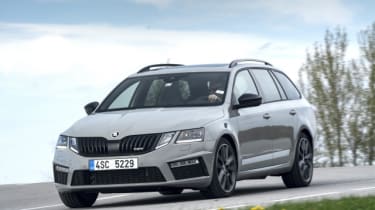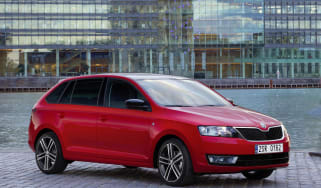Skoda Octavia vRS Estate review – the perfect balance of practicality and performance?
It’s not the fastest or the most exciting, but few cars cover all bases quite as well as the Octavia vRS Estate
When asked to recommend a car to someone – something extremely practical and relatively economical to run, but still fun to drive – the safe answer is always the Skoda Octavia vRS Estate.
Its non-premium badge means that it’s affordable, while its massive body means there’s a huge boot and tons of space for passengers. Even people who have what marketing departments would call ‘active lifestyles’ – the sort of people who cycle, kayak, climb mountains and hike all in one weekend – will find it capacious enough for all their kit.
> Find out what the Volkswagen Golf GTI is like to drive
None of that sounds all that exciting, admittedly, but this sporty estate has some VW Golf GTI and GTD-derived powertrains and a vRS-tuned chassis to add some thrills to its eminently sensible body and interior. Such a combination makes the Skoda Octavia vRS Estate a truly gifted all-rounder.
Technical highlights
As well as the plethora of ingenious touches to make living with the vRS an absolute doddle – including a parking ticket holder, a bin and the way the cruise control stays engaged when you change gear (even with the manual gearbox) – it also comes with a slick, easy-to-use satnav as standard.
More reviews
In-depth reviews
Reviews
If you want anything especially sophisticated on the mechanical side – over and above the MacPherson strut front and multi-link rear axle – you have to turn to the options list. Adaptive dampers are available for £860 and a limited-slip differential only comes on the top-of-the-range 245 model.
Engine, transmission and 0-60 time
There’s a choice of two four-cylinder turbocharged 2-litre engines (a petrol and a diesel). The direct-injection petrol engine produces 227bhp and 258lb ft of torque and drives the front wheels through a six-speed manual gearbox or a six-speed dual-clutch automatic. Unusually, it’s the manual version that’s the faster-accelerating car – it reaches 62mph from a standstill in 6.8sec, while the DSG car takes 7.0sec.
> Read our review of the entire Skoda Octavia vRS range
As well as the standard petrol model, there’s also the vRS 245. With 242bhp it has 15bhp more and helps control that extra grunt with a limited-slip diff. This car is only marginally faster than the basic car to 62mph, completing the dash in 6.7sec. It too is front-wheel drive and can be equipped with a manual or a DSG transmission, however even though it has the same amount of torque as the basic model, its extra power means it qualifies for VW’s wet-clutch seven-speed dual-clutch ’box. As a result, both gearboxes are good for the same acceleration time.
Finally, there’s the diesel-engined vRS. The 2-litre derv engine makes 22lb ft more torque than the petrols with 280lb ft, but it’s down on power, with just 181bhp. Both the manual gearbox and DSG transmission (the six-speed) can be matched to the diesel engine, and just like the basic petrol version the auto is 0.1sec slower to 62mph – the manual car reaches 62mph in 8.3sec.
That’s not the end of the story, however, as there’s one final model. A four-wheel-drive version, it’s only available with the 181bhp diesel engine and the six-speed DSG transmission, but it can accelerate from 0 to 62mph in 7.7sec.
What’s it like to drive?
The vRS’s hot hatch underpinnings are immediately evident as you point the Octavia’s four-eyed face down a B-road. Rather than being a calm, super grown-up estate car, it’s boisterous and lively.
The petrol engine pulls hard and it revs smoothly, just as we’ve come to expect from that VW Group EA888 motor. The noise it makes, mostly digitally augmented, lacks some sparkle, and there’s little in the way of aural reward as it reaches 7000rpm, but it still pulls right to its red line.
The diesel isn’t as impressive; it only feels comfortable being worked in its mid-range and that erodes some of the vRS’s eager attitude. But, at least the sound generated through the speakers masks much of the rattly diesel noise. The DSG gearbox doesn’t suit the oil burner’s attitude; in full auto mode it holds on to the revs rather than making the most of the grunty band between 2500 and 3000rpm.
But it’s hardly a chore opting for the manual. Whether it’s the diesel or petrol version the gearshift is smooth, close and very satisfying to whisk through the ratios.
With standard-fit 18-inch and optional 19-inch wheels, it’s not a surprise the vRS isn’t the most comfortable-riding car. The optional Dynamic Chassis Control (adaptive dampers to you and I) makes the chassis feel a little more forgiving, but never truly plush. However, the body’s structure is more than rigid enough to withstand hits from bumps and potholes without sending nasty tremors through the car. As a result, the vRS feels tough and robust, ready to attack the next B-road.
Much of the ride’s firmness can be excused once the Octavia has been weaved through a few corners. It resists body-roll well, making it feel lively and agile, and it stays in tune with the road, never feeling wallowy or cumbersome.
Only when you want more from the car – have that little extra degree of involvement, really have an authority on the car’s attitude through a corner – does the vRS not quite match its hot hatch brethren. Its polished driving characteristics hardly fall apart the further you push, but they just allow you greater access to a more playful side.
The LSD in the 245 Octavia does give you an extra tool to influence the vRS mid-corner. Squeeze the throttle early in a bend and you can feel the front axle tense and keep you on line. Backing off then lets the nose ease out wide. It’s not revelatory, and doesn’t make the Octavia into the most aggressive of road cars, but it does make it more rewarding.
The Octavia vRS Estate takes the sophistication that runs through every MQB platform-based VW Group car (Golf, Seat Leon, Audi A3 etc) but, rather than feeling dull or tepid, it adds a dollop of hot hatch fun to the recipe, too. It might not be the very last word in driving thrills – there just isn’t quite the driver involvement to make it one of the very best – but there are few new cars that would fill a space on your drive, and do everything your bonkers track car or impractical sports car couldn’t do, quite like the Skoda Octavia vRS Estate.
Price and rivals
The Skoda Octavia vRS Estate starts from £26,890, and goes up to £30,215. The range is bookended by the manual 227bhp petrol model (the cheapest), and the diesel four-wheel-drive DSG version (the most expensive). Whichever engine you go for, the DSG ’box is an extra £1390, and the adaptive dampers are another £860.
Our favourite vRS Estate is the £29,300 245. Paying £2410 for just 15bhp more, some bigger wheels, some slightly larger brakes and a limited-slip differential certainly isn’t cheap, especially as we’d also recommend the Dynamic Chassis Control, but it is worth it. Stick with the manual gearbox, which we’d also recommend, and you’ll save some money.
The Octavia vRS Estate isn’t the only hot MQB-based wagon in the VW Group. The SEAT Leon ST Cupra 300, with 296bhp and an LSD as standard, is a far more wild prospect, and the VW Golf GTD Estate is a little more wieldy than the Octavia. However, at £30,910 and £31,200 respectively both are more expensive and neither are as practical as the Skoda.
> SEAT Leon Cupra 300 review - More exciting than a Golf GTI?
To get into a car that’s anywhere near as capacious as the Octavia you won’t find anything anywhere near as sporty. A comparably priced VW Passat Estate will only have a 148bhp 1.4-litre engine, while the cheapest BMW 3-series Touring (a 318i) costs £29,110 and only has 134bhp.





